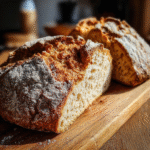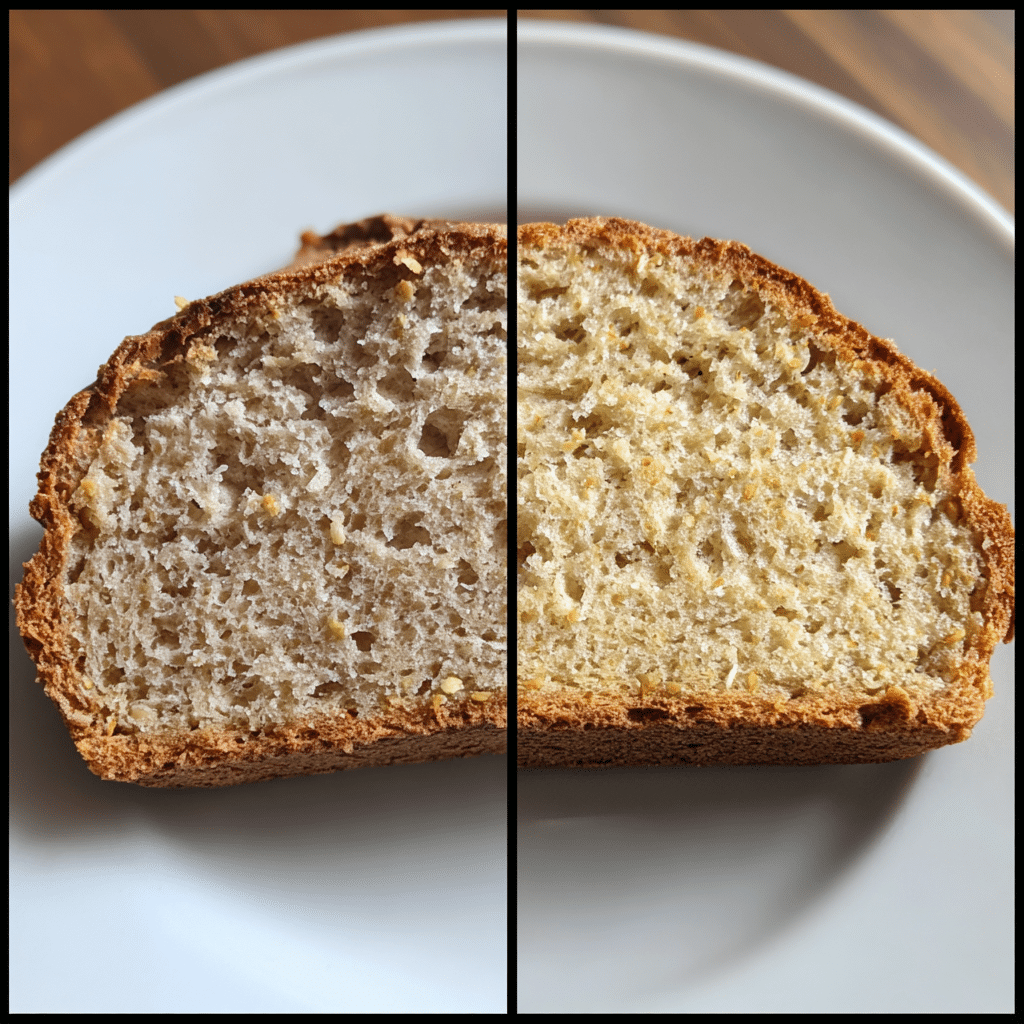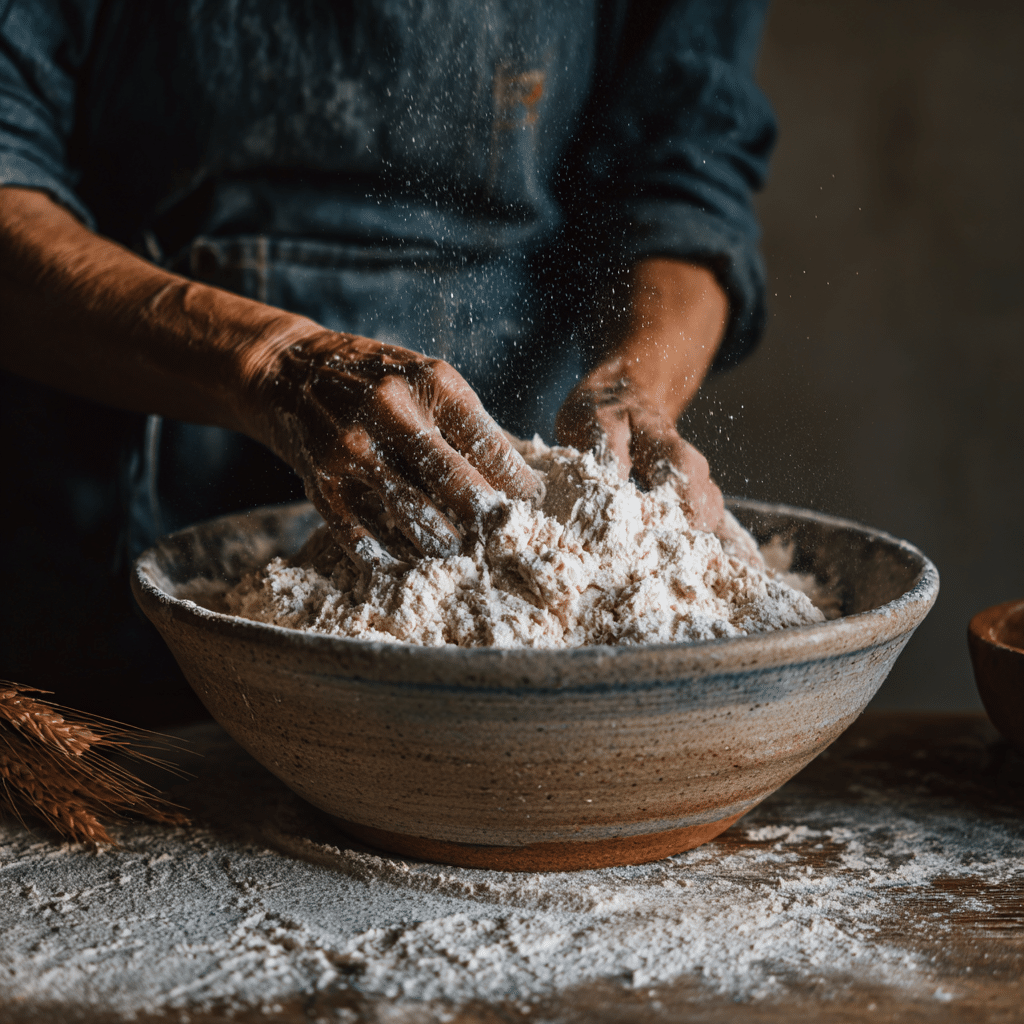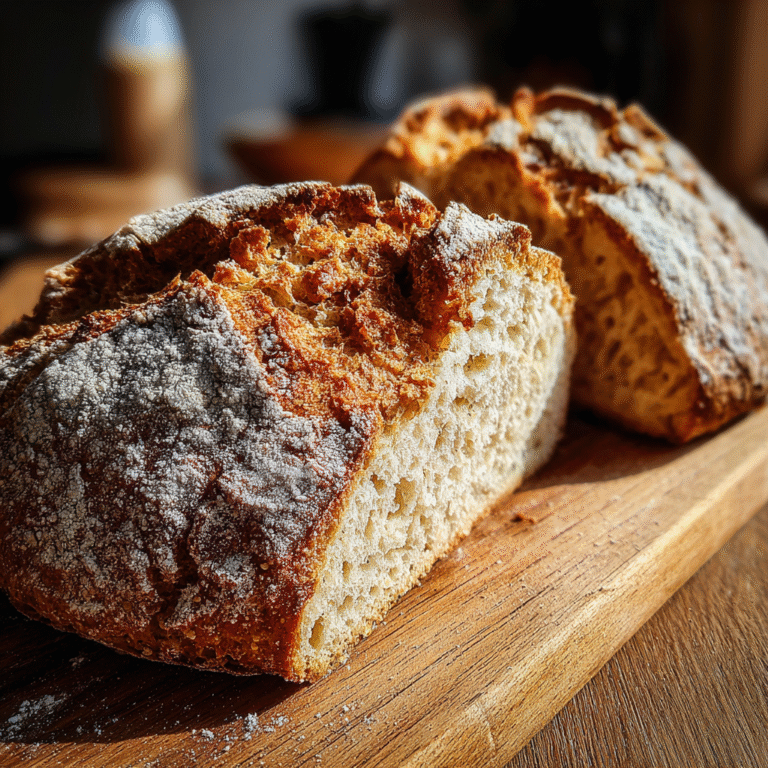Sourdough discard soda bread is quickly becoming a favorite among home bakers looking to reduce waste and bake deliciously fast loaves. By combining leftover sourdough starter discard with the quick-rise magic of baking soda, this bread offers the best of both worlds: deep sourdough flavor and the simplicity of traditional soda bread. Whether you’re looking to cut down on food waste or whip up a rustic loaf without yeast, this is the solution.
In this guide, we’ll dive deep into everything you need to know about sourdough discard soda bread—from how it compares to classic sourdough and what makes it healthy, to how baking soda reacts with discard, and what else you can make with your leftover starter. You’ll even learn to store discard properly for future use and explore eco-friendly baking tips.
Check out Sourdough Discard Biscuits for another creative way to use your starter waste.
Table of Contents
What is Sourdough Discard Soda Bread?
Understanding sourdough discard and soda bread individually
Before we get into baking, let’s break down what sourdough discard soda bread really is.
Sourdough discard refers to the leftover portion of sourdough starter that you remove during regular feedings. While often thrown away, this discard still contains live cultures, mild acidity, and plenty of flavor—just not enough leavening power on its own.
Soda bread, on the other hand, is a quick bread made without yeast. It relies on baking soda, often combined with an acid like buttermilk or yogurt, to create rise during baking. It’s a no-fuss, no-wait bread with a rustic feel and crumbly texture.
The beauty of combining sourdough discard with soda bread
When you put the two together, you get sourdough discard soda bread—a quick, flavorful, and sustainable loaf that’s perfect for everyday baking. The acidity in the sourdough discard activates the baking soda, making the dough rise naturally and adding layers of complex flavor.
The result is a hearty, tangy bread with a soft interior and crisp crust, ready in under an hour. It’s a great entry point for beginners and a favorite for experienced bakers looking to use every part of their sourdough starter. Plus, it’s incredibly versatile—you can mix in herbs, cheeses, or even dried fruit. If you’re short on time but still crave something homemade and satisfying, this bread is the answer.
Print
Sourdough Discard Soda Bread: A Healthy and Simple Way to Use Up Starter Waste
- Total Time: 45 minutes
- Yield: 1 loaf
Description
A quick, rustic loaf that combines the tang of sourdough discard with the speed of baking soda, perfect for reducing food waste and baking something wholesome in under an hour.
Ingredients
- 3 cups all-purpose flour
- 1½ tsp baking soda
- 1 tsp salt
- 1 cup unfed sourdough discard
- 1 cup buttermilk
- Optional: 2 tbsp melted butter
Instructions
- Preheat your oven to 425°F (220°C) and line a baking sheet with parchment paper.
- In a large bowl, combine flour, baking soda, and salt.
- Stir in sourdough discard and buttermilk until just combined.
- Turn the dough out onto a floured surface and shape into a round loaf.
- Score the top with an ‘X’ using a sharp knife.
- Transfer to the baking sheet and bake for 30–35 minutes, until golden brown and it sounds hollow when tapped.
- Let cool before slicing and serving.
Notes
Customize with herbs, cheese, or dried fruit. For a sweeter loaf, substitute buttermilk with milk and add honey and cinnamon.
- Prep Time: 10 minutes
- Cook Time: 35 minutes
- Category: Bread
- Method: Baking
- Cuisine: American
Is Soda Bread as Healthy as Sourdough?
Nutritional comparison between soda bread and traditional sourdough
One of the most common questions for health-conscious bakers is: Is soda bread as healthy as sourdough? The answer isn’t black and white—it depends on your dietary goals and how each bread is made.
Traditional sourdough bread undergoes a fermentation process that helps break down gluten and phytic acid. This makes it easier to digest and increases nutrient absorption. The wild yeast and bacteria in sourdough also create organic acids, which help keep blood sugar levels stable and make the bread lower on the glycemic index compared to regular bread.
Soda bread, however, skips fermentation entirely. It’s quicker to make and doesn’t rely on yeast or time-consuming proofing. While that makes it convenient, it also means you miss out on some of the gut-friendly benefits found in long-fermented sourdough. However, when you combine soda bread with sourdough discard—as in sourdough discard soda bread—you introduce some of those beneficial acids and flavors back into the mix.

So nutritionally, sourdough discard soda bread can fall somewhere in between traditional soda bread and fully fermented sourdough, offering the ease of one with some benefits of the other.
| Feature | Soda Bread | Traditional Sourdough | Sourdough Discard Soda Bread |
|---|---|---|---|
| Fermentation | No | Yes | Minimal (via discard) |
| Yeast | Baking soda only | Wild yeast | Baking soda + sourdough acids |
| Digestion | Moderate | Easier to digest | Easier than soda bread |
| Blood Sugar | Higher glycemic index | Lower GI | Moderate GI |
| Time to Bake | Under 1 hour | 8–24 hours | Under 1 hour |
Gut health, fermentation, and glycemic index differences
Fermentation plays a major role in the health benefits of sourdough. It breaks down gluten, which can be helpful for people with mild sensitivities (note: not for celiacs), and produces lactic acid, which supports gut health. Sourdough bread is also lower on the glycemic index due to the slower fermentation process, which helps control blood sugar spikes.
With sourdough discard soda bread, you’re not getting the full fermentation process—but you are still using fermented material (the discard), which retains some of the sourdough’s probiotic benefits. While these benefits are less potent than in long-fermented loaves, they’re a meaningful improvement over plain soda bread.
If you’re looking for a healthier bread option but don’t have the time to wait for full sourdough fermentation, sourdough discard soda bread offers a balanced compromise. It brings a bit of tang, a bit of health, and a lot of convenience.
Don’t miss our list of Gluten-Free Mexican Food if you’re looking to explore bread-free alternatives that are gentle on the gut.
What Baking Soda Does to Sourdough Discard
The science behind baking soda in quick breads
Baking soda (sodium bicarbonate) is a leavening agent that reacts with acids to produce carbon dioxide gas. This gas gets trapped in the dough, causing it to rise. In traditional soda bread, that acid typically comes from buttermilk or yogurt. But in sourdough discard soda bread, the acidity naturally comes from the fermented sourdough starter, making the combination ideal.
The magic lies in that acid-alkaline reaction. Sourdough discard is naturally acidic due to the lactic and acetic acids produced during fermentation. When mixed with baking soda, these acids create a bubbly reaction that lifts the bread without needing commercial yeast. The result? A rustic loaf with a moist crumb, crisp crust, and subtle tang.
This interaction is what gives sourdough discard soda bread its quick-rise structure and unique flavor. Unlike yeast-based doughs that need hours to ferment and proof, this chemical leavening happens almost instantly in the oven.
How baking soda interacts with sourdough’s natural acidity
The acidity in sourdough discard plays a dual role. First, it helps baking soda release carbon dioxide more efficiently, allowing the dough to expand quickly during baking. Second, it balances the often harsh or soapy taste baking soda can leave behind when not properly neutralized.
Here’s what happens in your dough:
- Acid + Baking Soda = CO₂ + Salt + Water
- CO₂ gas forms bubbles → dough rises rapidly
- The discard also brings enzymes and flavor compounds that enhance aroma and taste
Because of this dynamic, sourdough discard soda bread not only rises well but also browns beautifully and has that slightly sour depth without long fermentation. It’s chemistry you can eat.
Plus, you’re skipping long wait times and complex steps, making this perfect for busy weekdays or last-minute baking.
Learn more about delicious Cloud Bread Breakfast Sandwich for another fun way to use alternative leavening and high-protein baking.
Delicious Recipes with Sourdough Discard
Basic sourdough discard soda bread recipe
If you’re new to using discard in bread, start with this basic sourdough discard soda bread recipe. It’s fast, simple, and requires no yeast or kneading.
Ingredients:
| Ingredient | Quantity |
|---|---|
| All-purpose flour | 3 cups |
| Baking soda | 1½ tsp |
| Salt | 1 tsp |
| Sourdough discard (unfed) | 1 cup |
| Buttermilk | 1 cup |
| Optional: melted butter | 2 tbsp |
Instructions:
- Preheat your oven to 425°F (220°C). Line a baking sheet with parchment paper.
- In a large bowl, mix the flour, salt, and baking soda.
- Add the sourdough discard and buttermilk. Stir until just combined.
- Turn dough onto a floured surface and shape it into a round loaf. Score the top with an “X”.
- Bake for 30–35 minutes until golden brown and hollow-sounding when tapped.
- Let it cool before slicing.
This recipe delivers a rustic loaf with a slightly tangy flavor and soft crumb—perfect for soups, sandwiches, or just slathered in butter.

Creative twists: herbs, cheese, spices, and add-ins
The beauty of sourdough discard soda bread is how adaptable it is. Once you’ve mastered the basic version, try these fun and flavorful add-ins:
| Variation | Ingredients |
|---|---|
| Cheddar & Chive | 1 cup shredded cheddar, 2 tbsp chopped chives |
| Garlic & Herb | 1 tsp garlic powder, 1 tbsp Italian herbs |
| Seeded Whole Wheat | 1 cup whole wheat flour + ¼ cup mixed seeds |
| Cranberry Walnut | ½ cup dried cranberries, ½ cup chopped walnuts |
To incorporate these, simply fold them into the dough after the wet ingredients are added. You can even brush the top with melted butter or sprinkle with oats for added texture.
Want a sweet version? Swap buttermilk for milk and add honey, cinnamon, and raisins. It’s still a one-bowl, no-knead recipe—ideal for spontaneous baking.
This type of bread proves you don’t need hours of fermentation to enjoy real flavor. In less than an hour, you’ve got something hearty, homemade, and incredibly satisfying.
Discover great ideas like Chaos Cakes if you love customizing bakes with unique mix-ins and wild creativity.
Other Things You Can Make with Sourdough Discard
Pancakes, crackers, muffins, and more from discard
If you love baking sourdough discard soda bread, you’ll be thrilled to know that the uses for your leftover starter go far beyond just bread. Discard is incredibly flexible—it adds flavor, structure, and moisture to a wide range of baked goods.
Here are some tasty, beginner-friendly ideas:
| Recipe Idea | Why It Works |
|---|---|
| Pancakes | Light, fluffy texture and rich flavor from natural fermentation |
| Crackers | Tangy and crisp—great with herbs and seeds |
| Muffins | Extra moist with subtle sourdough depth |
| Waffles | Crispy outside, soft inside—discard replaces some flour/liquid |
| Flatbread | Quick stovetop version that works beautifully with discard |
| Brownies | Yes—chocolate brownies with sourdough discard are amazing |
All of these recipes work well with unfed starter, just like you use in sourdough discard soda bread. And many don’t require additional rising agents beyond baking soda or baking powder, making them perfect for fast weekday bakes.
Not only do they help you reduce waste, but they also elevate your food with layers of flavor no plain flour could ever match.
Can you add sourdough discard to anything?
Technically, no—not everything. But you can add sourdough discard to many recipes when you’re mindful of its balance between flour and liquid.
Think of sourdough discard soda bread as your blueprint. Just as the discard boosts flavor and structure in that bread, it can do the same in cookies, pizza crusts, savory pancakes, or even stew. If a recipe needs tang or texture, discard can enhance it.
Some quick guidelines:
- Start with ¼ cup discard per recipe
- Reduce equal parts flour and liquid
- Watch for acidity in recipes with lemon, vinegar, or buttermilk
- Taste test as you go—discard flavor ranges with age
Used creatively, discard is like a secret ingredient that works behind the scenes to upgrade even the most basic recipes.
Looking for inspiration? Try this Banana Coffee Syrup as a topping for your discard pancakes or muffins.
How to Store and Reuse Discard Efficiently
Storing sourdough discard: fridge vs freezer
If you’ve baked sourdough discard soda bread even once, you probably realized how fast that discard builds up. But don’t toss it out—storing it the right way ensures you always have some on hand for future recipes.
Here’s how to store your discard depending on when you plan to use it:
| Storage Method | Shelf Life | Best For |
|---|---|---|
| Fridge | 5–7 days | Frequent baking (weekly) |
| Freezer | Up to 3 months | Occasional baking (monthly or less) |
To refrigerate, keep the discard in a clean, airtight jar. Label it with the date so you know when it’s nearing its limit. Stir it before using, as some liquid (“hooch”) may form on top—this is normal.
For freezing, portion the discard into small containers or zip-top bags. Freeze flat to save space, and thaw it overnight in the fridge before using it in sourdough discard soda bread or other bakes.
By building a small discard inventory, you’ll always be ready to whip up a loaf, crackers, or pancakes whenever the mood strikes.

Reducing food waste with discard-based recipes
One of the most satisfying parts of making sourdough discard soda bread is knowing you’re baking more sustainably. Home bakers toss out tons of discard every year, but every cup reused is a win—for the planet and your wallet.
Here’s why it matters:
- You’re minimizing waste from an active fermentation process
- You save on extra ingredients since discard replaces part of the flour
- Discard recipes often use fewer commercial leaveners like yeast
Every time you make a loaf or batch of discard muffins, you’re putting your starter to full use. Plus, when you store and use discard smartly, you’re always a step ahead on meal prep—ready for a quick bread or treat without having to start from scratch.
So whether it’s a rustic loaf of sourdough discard soda bread or a tray of tangy crackers, you’re baking smarter, not harder.
Conclusion: Start Baking with Sourdough Discard Soda Bread Today
If you’ve been tossing out your sourdough discard, now you know there’s a better way. Sourdough discard soda bread is not just a smart use of leftovers—it’s an easy, delicious, and sustainable way to enjoy fresh-baked bread in under an hour.
You get the tangy flavor of sourdough without the wait, and the simplicity of soda bread without sacrificing nutrition. Plus, with countless flavor add-ins and storage tips, you’ll always be ready to turn your starter waste into something special.
Don’t miss our fun dessert twist with Scrambled Cookie—a sweet way to use up ingredients in creative ways.
Frequently Asked Questions About Sourdough Discard Soda Bread
Is soda bread as healthy as sourdough?
Soda bread is typically made without fermentation, which means it lacks the probiotic and digestive benefits found in long-fermented sourdough. However, it can still be nutritious—especially when made with whole grains. When you make sourdough discard soda bread, you’re introducing some of sourdough’s benefits back in, such as improved flavor and better digestibility. While it may not match fully-fermented sourdough, it’s a much healthier alternative to plain white bread.
What can I make with sourdough discard?
Sourdough discard is incredibly versatile. In addition to sourdough discard soda bread, you can make pancakes, muffins, waffles, crackers, biscuits, cookies, brownies, and even flatbreads. It adds moisture, depth, and a slightly tangy flavor to recipes—plus, using it helps reduce food waste and stretches your flour supply.
What does baking soda do to sourdough?
Baking soda reacts with the natural acids in sourdough discard, releasing carbon dioxide. This reaction causes the dough to rise quickly, making it perfect for quick breads like sourdough discard soda bread. It also neutralizes some of the sourness, giving the bread a balanced flavor while creating a tender crumb and golden crust.
Can I add sourdough discard to anything?
You can add sourdough discard to many recipes, but not literally everything. It works best in baked goods that can accommodate its moisture and acidity. Stick with items like quick breads, batters, cookies, and doughs. Use it as a partial replacement for both flour and liquid. If you’re ever unsure, use sourdough discard soda bread as your template—then expand from there.

